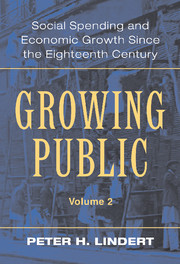14 - A Guide to the Tests
Published online by Cambridge University Press: 12 January 2010
Summary
To test the many plausible theories about social spending and economic growth requires both good historical data and careful test design to make real-world judgments about the different historical forces that theory says could have played key roles. This chapter takes the first step, by introducing the whole empirical framework to be used in this volume.
WHAT KIND OF LABORATORY?
International historical samples should consist of countries and eras for which any differences in the definition of social transfer spending have been ironed out. Such samples are available, but only for several countries and only for three eras. The only available sample period before World War II consists of twenty-one countries' experiences in the six decadal benchmark dates 1880, 1890, 1900, 1910, 1920, and 1930. This sample of 126 observations becomes:
The 1880–1930 sample. The twenty-one countries of the 1880–1930 sample are Argentina, Australia, Austria, Belgium, Brazil, Canada, Denmark, Finland, France, Germany, Greece, Italy, Japan, Mexico, Netherlands, Norway, Portugal, Spain, Sweden, the United Kingdom, and the United States.
All these countries are viewed as sovereign nations, despite limitations on the sovereignty of Australia, Finland, and New Zealand before the turn of the century. World War I brought some territorial changes in our countries. Our “Austria” switched from the Austrian half of the Austro-Hungarian Empire to today's Austria. Germany lost some eastern territories and lost Alsace-Lorraine to France. Italy gained territory from Austria. The United Kingdom lost most of Ireland. The territories and population covered by our nations changed accordingly. For the most part, these changes do not appear to have had any major effects on the variables used here, though I did perform side-tests that included shift terms for Austria and for Finnish independence.
[…]
Information
- Type
- Chapter
- Information
- Growing PublicSocial Spending and Economic Growth since the Eighteenth Century, pp. 20 - 30Publisher: Cambridge University PressPrint publication year: 2004
